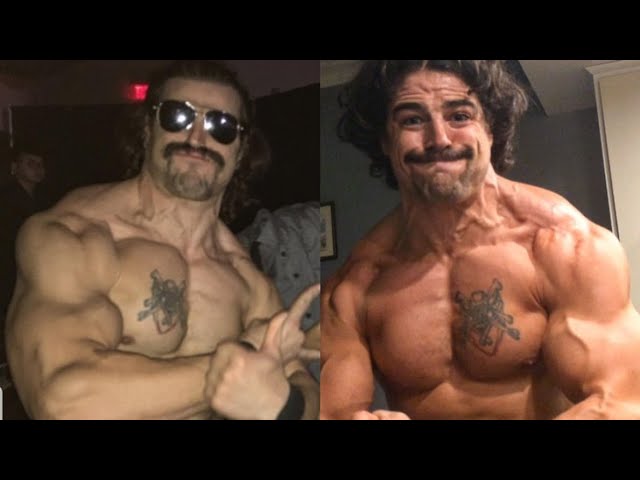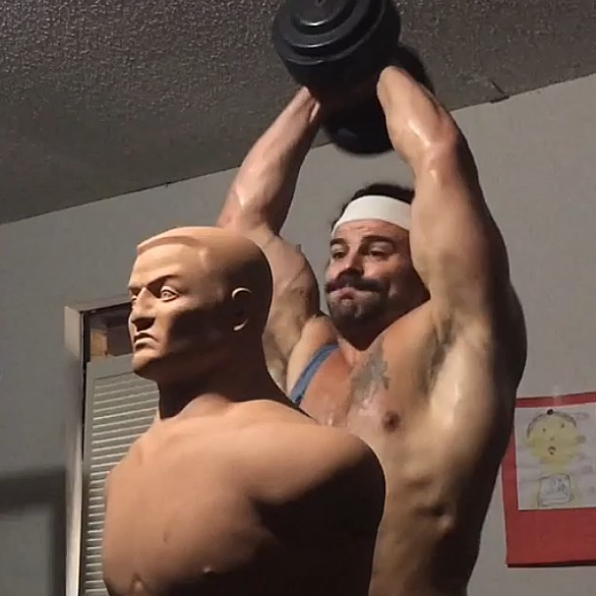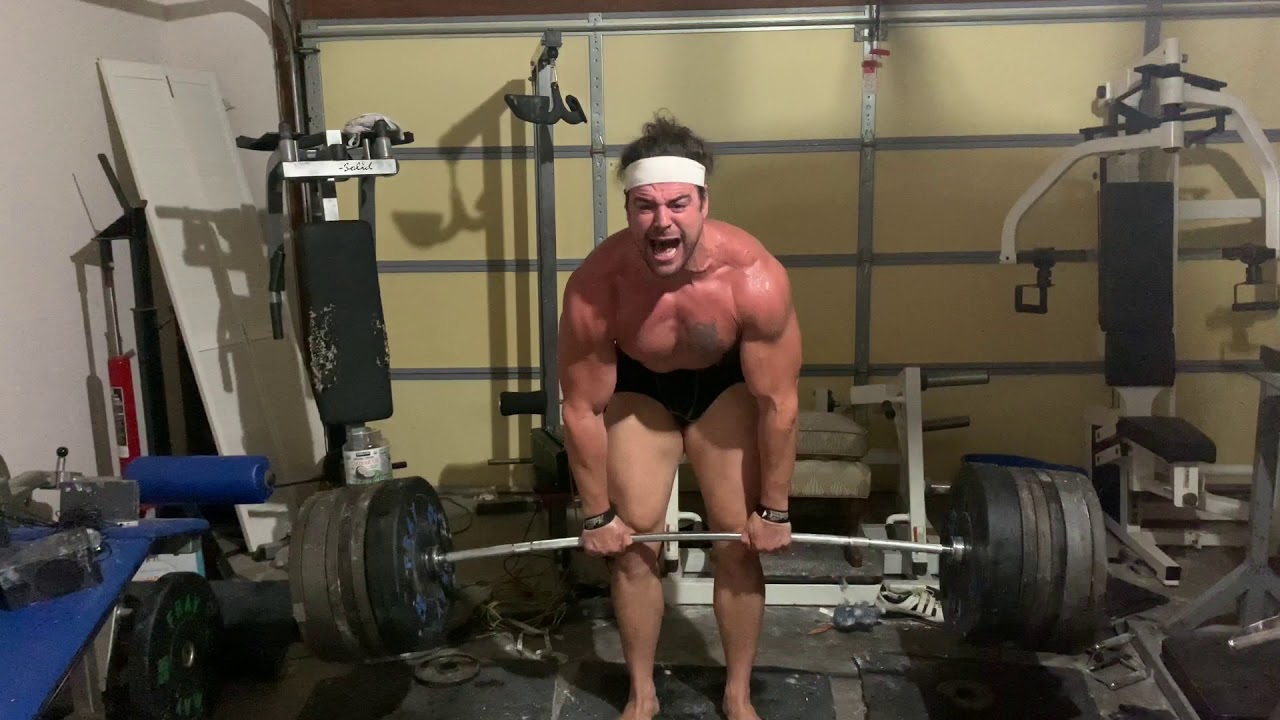 Introduction
Introduction
If you’ve never heard of Eric Bugenhagen, you’re in for a treat. Eric Bugenhagen, aka the Bugez, aka Ric de la stick aka Sticky Ricky aka Stick Del Hagen was a College Athlete on the University of Wisconsin Wrestling team. After graduating, Eric spent some time as a strength coach, even returning to the team as their strength coach while trying to pursue a career in wrestling on the side. Eric Bugenhagen rose to a small popularity on YouTube about 8 years ago for his insane lifts and his intense enthusiasm. Other channels took notice of his charisma and energy, reaching out to collaborate, and Eric’s career took off from there. Eric is known for playing a type of character, getting into uploading humerous videos with stock sound effects and funny titles with his devoted fans playing along in the comments. After his rise to internet cult following, Eric’s wrestling career started to take off with Eric finally getting bigger and bigger roles in the WWE, where now he is apart of the main cast of wrestlers. I’ve been following Eric for years, always inspired by his energy, humor and his strength in the gym. He had an unconventional take to lifting that opposed what mainstream social media was promoting at the time which was to eat in a slight caloric surplus, to stay lean and follow bodybuilding routines. Meanwhile, Eric was preaching to eat to fuel your body with high caloric foods like dates, peanut butter, fig bars and even on the extreme end with eating raw garlic, onions and beets. I was always inspired with Eric’s creativity, who always sought to try new things to improve his game from weird lifts or eating pet food… (definitely won’t be trying that). One day, I said fuck it and gave his method a go. I fell in love with the style of training, it’s so much fun! Training should be fun, you should leave the gym feeling happy with this method. And at the end of the day as a normal lifter who won’t be competing or making a living from training, that’s the most important thing about exercise- it improves your overall quality of life and makes you a healthier person.
 The Method
The Method
 Warning: This method is not for beginners. It requires a couple years of experience hammering techniques of the main movements. It also requires somebody who is not obsessive about eating or looking a certain way. In this style of training, you have to drop those because you won’t be training to look a certain way and you will need to eat a certain way as described later.
Warning: This method is not for beginners. It requires a couple years of experience hammering techniques of the main movements. It also requires somebody who is not obsessive about eating or looking a certain way. In this style of training, you have to drop those because you won’t be training to look a certain way and you will need to eat a certain way as described later.
Eric is known for his long, 20 minute rants about one topic, but funny enough, he hasn’t described his training in great detail apart from a few details going over a simple method. So simple in fact, that it seems like he’s hiding things because it goes against what conventional wisdom tells us how to train. Traditionally with bodybuilding programs, you split your program up into training body parts once or twice a week with a ton of volume each session, really hammering a muscle in, then taking 2-3 days of rest a week. With traditional powerlifting methods, you train the Squat, Deadlift and Bench Press with different variations multiple times a week, while manipulating volume, intensity over the course of training blocks. Trainees are used to following spreadsheets and filling in the numbers, believing that the only way to make progress it to follow formulas in a spreadsheet. The way Eric trains, coined by an old training partner as the ‘Wisconsin Method’, throws all that out the window. From my research, this is the program:
Step 1: Pick a lift
Usually, this should be an unconventional lift or something more athletic but really any compound lift that you can load heavy should suffice (I would personally describe an unconventional or odd lift as a lift that you would definitely take note about if you saw it in a commercial gym- think Jefferson Deadlifts, Zercher Squats, Trap Bar Overhead Press, etc). This lift should be something you WANT to do. This is key here that I’ll talk about later. Let’s say for example, you choose a behind the neck push press because you like the movement but your overhead press isn’t as strong as you would like.
Step 2: Go to the gym and warm up with lighter weight on that lift
Continuing with our example, you may do some Shoulder halos or some stretching/mobility work, then go into warm ups with the bar as you would heavy work on any program- except you include more warm-up sets to get your body really ready.
Step 3: Work up to a PR
Keep warming up with higher and higher weights until you reach a PR or a lift you’re satisfied with.
Step 4: Pack up and go home, do the same thing tomorrow
Step 5: Repeat this process until you stall and either switch to a different movement, or apply this same process to an adjacent lift
Let’s say you hit a bunch of PRs 3 days in a row for the behind the neck push press but you stall on day 4. If you really want to improve your press, you could switch to something like an overhead press with chains, axle press, Z-press and so on. Then circle back to your behind the neck push press and continue hitting PRs again. OR… if you were bored of pressing, you could switch to Jefferson Deadlifts.
Yep… that’s it. If you’ve never heard of this style before, you’re probably thinking, “WTF, there is no way you can make gains, you’re neglecting so many other body parts, so many other movements!! This isn’t optimal…”
And you wouldn't be wrong, Eric himself acknowledges that this may not be the most optimal way to train, but you can't deny the physique and strength he has cultivated through his years of training this way. Here's why I think it works: Strength is a skill. You've heard it so many times and you've probably seen it. When you train for a certain lift, you can get really strong but as soon as you stop training it consistently or you take a break from the gym, all that strength has disappeared. Your nervous system needs to become accustomed to handling heavy loads in certain movement patterns. You have the ability to squat X amount of weight, but if you aren't training for it, you can only squat a fraction of your truest potential. By training one lift every day, you're fast-forwarding that nervous system adaption. Instead of slowly adapting by training a lift twice a week over the course of months on a traditional program, you skip ahead and do it all and more in a week. When I used the Wiso Method to train Bulgarian Split Squats, on day 1 I could only bulgarian split squat 250 lbs but I had the potential to hit 305 lbs which was what I hit on the final day. I had to get my nervous system geared up to optimally use all my muscles in order to achieve what I had the potential to. By following traditional powerlifting programs, let's say you hit on average overhead press twice a week. Over the course of a 4 week training block, you hit the overhead press 8 times, each time with an RPE of about 8. With this style of training, you hit overhead press the same amount of times in a little over a week, rather than a month, and you would see way more strength gains than you would with the conventional powerlifting style. The conventional method tries to slowly improve all your lifts at the same time for a long period of time because this is how you would initially train for a meet where you hit all the powerlifts at one time. But with the Wisconsin Method, you specialize in one movement, you don’t "major in the minors" as Eric would say. It’s the difference of putting all your eggs into one basket while dispersing them among many. I'm not saying that any method is better than the other, Heck I've only been training this way for a few weeks. Just discussing the differences and why I believe I've seen so much improvement over those few weeks, the amount I would see in a year or more of training.
Another reason why this works is Step 6 of the method- eating… a lot. Eric is notorious for packing in calories, like it's a second job. He preaches to eat foods with high calories like dried fruits, bagels, drinking a gallon of milk a day and more. He even goes as far as carrying around a fanny pack of fig bars. Although he has stopped drinking a gallon of milk a day and mostly follows a vegetarian-esk diet now adays, logically, it makes sense. Everyday, you're sending a massive signal to your body to grow and you're giving you body plenty of resources to do that. But what I've found is that your body **NEEDS** this type of eating. I've been **RAVINOUSLY** hungry, I've been finding myself constantly snacking, and looking to those higher calorie foods jut to hold me over.
The final secret step is intensity. You've got to pick a lift which gets you excited, it makes you want to go to the gym after waking up- which is another reason to try odd lifts, ones you haven't done before which is fun to hit new PRs and try something new. To accompany that, Eric opts for a pot of coffee before training- which I don't do after kicking my caffeine addiction a year ago. Eric pumps loud metal music infused with blaring heavy guitar rifts and heavy drums. Eric can be found screaming before, during and after his lifts- an intensity which drew many of his viewers to become fans. But there's a method here. By getting yourself pumped, you are getting yourself in the zone and building up confidence to hit a lift. Eric's motto is,
>"It's a mindset!".
You have to get yourself in the mindset that you **CAN** hit that lift and you will. It's a good life lesson for fighting those self-deprecative thoughts in your head that say you can't.
I know that was a long description of Eric and his method but it really needed the background to really explain what it is and why it works.
#

My Personal Adaption of the Method
Like many of the readers, I was also a bit wary of only performing one lift per day- especially when I've seen Eric perform accessories and preach about 100 rep lateral raises or curls in some of his rants. I speculate two things: After Eric maxes out, he performs a bunch of accessories willy-nilly just to maintain those areas OR he has two training sessions, one max session and either another where he has a second workout to get some conditioning or cardio or accessory work in OR he hits some accessory or conditioning work whenever he has a free second throughout his day.
If you haven't read about my current training style in previous posts, here is the basic rundown: My only goals is to train everyday, no matter what. Minimum of 2 minutes. The Wisconsin method is another training every day method which I love. With my school demands being high and going into a career with a lot of travel, training is something that was and can be something easily neglected. This means that sometimes all I can get in on a busy day is a 5 minute conditioning session and that works great. But with the Wisconsin method, you need a minimum of 30 minutes to hit that PR. Some days, I may not have that kind of time. Here's a tip to myself and to the reader- work out in the morning. By intentionally waking up earlier and working out, you are making that time for training, before the rest of the days demands get to you. I say this, but I have yet to train first thing in the morning but it's something I hope to implement when I return to school.
For those afternoon or evening trainees, I suggest that after you hit a warm up lift, perform an easy RPE 6 or 7 accessory lift right after as a superset (Superset all your warm-up sets). For example, while I was training the Axle Press, after I hit a warm up for the press, I did 5-7 pullups. This may not seem like much but if you have say 8 warm up sets before your max attempt, that’s 8 mini sets of pullups, over a week is 56 mini sets and somewhere between 280 and 392 pullups- that's a lot of pullups. This is in 'Greesing the Groove style' so this is not a set that you should be pushing yourself to do. In similar style, if I have time OR take 10 minutes at a separate time of the day, I choose 2-3 accessories to perform in giant set style right after my max attempt. For example, After I hit my axle press, I wanted to work on my heavy swings and I consider my abs a weak point, I hit some landmine abs, swings and landmine split squats for 2 or 3 rounds after my max attempt. Again these weren't anywhere close to failure, probably an RPE 7 at most. These are just getting volume in, 2-3 sets of these accessories is 16-18 sets in a training cycle, 14-21 in a week. So here is what a full Cole-adapted Wisconsin training would look like:
- **Main Lift:** Axle Press
- **Optional:** Halos, Shoulder Mobility
1. Warm up Axle Press
2. Superset with Pullups
3. Hit Axle Press PR
4. 2-3 Rounds of Landmine Lunges, Landmine Abs and Swings
For my first cycle of this style, I wanted to see how strong my Overhead Press could get. I found the axle bar more comfortable for me so I chose that lift. The first day, I hit a 160 lb press that was pretty slow. The next day I attempted a 168 press and failed, then hit a 160 lb with no belt (mini pr). The next day, I couldn't hit the actual gym so I opted to hit some Handstand Pushups (with a slight angle, not totally 90 degrees) for 3 rep PR and did some conditioning work after. The following day I hit that 168 lb PR on the axle press. The 168 felt very difficult so I decided to rotate to the kneeling landmine one arm press where I hit a PR the following day for 105 lbs of weight on the bar. The following day I hit 110 lbs. Then rotated to the Axle Z-Press and hit a 138 lbs press with a back-off set. The following day I hit 146 lbs with band for the Z-press. The following day I yet again couldn't make it to the gym so I hit 2 90 degree Handstand Pushups, did some jump rope and rows afterward. The final day I hit 180 lbs for the Axle Press, setting an all time personal record and adding 20 pounds over the cycle.
For the Bulgarian split squats, I had no deviations, working up everyday in a new PR except for one day where I went on a run instead. Went from 250 lb Bulgarian Split Squat to 305.
#

Issues with the method
My main gripe with the training style is that it requires you to always have access to a gym with proper equipment and an hour to train everyday. As someone who does not consistently have access to proper equipment because of shitty College Gyms nor guaranteed time to train because of a busy schedule, that is the biggest challenge. With my previous training style, every daily session was easily adapted to these variations and I allowed me to train cardio and conditioning like I wanted. With this method, it's hard to adapt and allow for time to have separate sessions to train cardio and conditioning.
First thing I have been playing around with is if you don't have time to access the gym, at home, hit a bodyweight or movement similar to the one you are focusing on with whatever tools you have at home. For example, while training for the Axle Press, when I couldn't make it to the gym, I trained the Handstand Pushup at home. I'd imagine at school if I was training a squat, I would use my sandbags for a split squat at home. The goal is to choose something that has as much resistance as possible OR, like Pavel says, "if you can't train heavy, train fast." Here are some replacement ideas for each movement:
#### Squat:
Pistol Squats (Loaded)
Vertical Jumps (Seated to jumping, load up a backpack or hold some weight)
Explosive Bulgarian Split Squats
#### Horizontal Push:
One Arm Pushups
Dips
Weighted Pushups
#### Hinge:
Swings
Nordic Curls
Explosive band Good Mornings
Single Leg Deadlift Variations
Suitcase Deadlifts
Reverse Hypers
#### Vertical Push:
Handstand Pushups
Depth Pike pushups
Weighted Pike Pushups
Pull stuff do Pull-up and row variations obviously
Another advantage to this is that if you have time, working up to these will take significantly less time than a barbell, so you have more time for cardio, conditioning or accessory work. Or, you could just do a pump workout. If you take a day or two over the course of a couple weeks to not train traditional Wisco but you are still training, I don't think the world is going to spite you. Again, it’s a made up training style, make up what you want.
#

Update: February 2023
So I'm returning to this post a couple of months after I started this routine. I decided after two months after trying out this method, although it was a lot of fun, I wasn't in the right situation for it. At school, the school gym I train in
#

Conclusion
The Wiso method is a training style where you choose a movement and max out everyday until you get bored. I've tried it myself and made some adaptions to my life style and training method. After being a fan of Eric's for years, I finally tried his style and I've been absolutely loving it. If you want to hit some crazy PRs, have a blast in the gym, try new lifts and eat a ton of carbs and get swole, try this method.

 Introduction
Introduction
 The Method
The MethodWarning: This method is not for beginners. It requires a couple years of experience hammering techniques of the main movements. It also requires somebody who is not obsessive about eating or looking a certain way. In this style of training, you have to drop those because you won’t be training to look a certain way and you will need to eat a certain way as described later.




